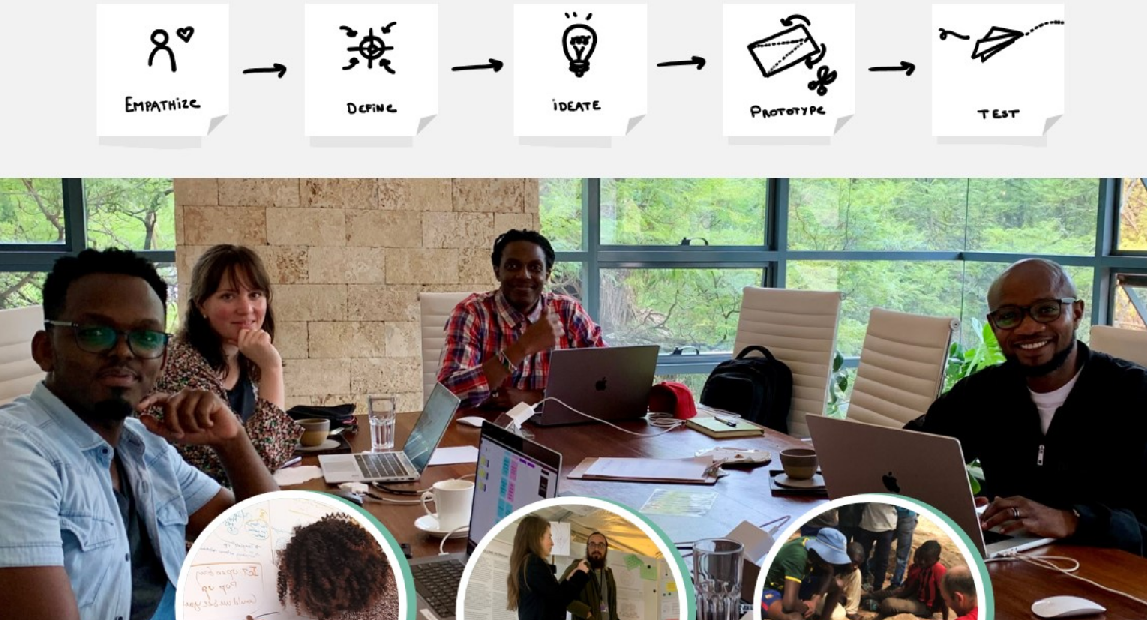The world is a complicated place, and the problems humanitarian organizations are trying to help solve are only getting more and more complex. For the ICRC ‘Design Thinking’ is a methodology that can help solve tricky problems with innovative ideas, imagining efficient solutions for real world needs.
To the uninitiated, design thinking might rank high in the league table of buzzy catchphrases but it’s much more than that and has become a priority for the ICRC. Why? Because design thinking has proven itself to be an efficient methodology for creative problem solving.
It’s about putting in the work to understand people in order to truly comprehend their needs. It’s about creating solutions to address these needs, prototyping ideas, testing them, and seeking feedback early and often to iterate and improve what works, all while keeping the needs of the end users front and centre.
Timothy Grosser, Chief Information Officer, Monica Scott, Experience Design Manager and Martin Kibisu, Studio Lead of the Nairobi Design Centre, agreed to shed some light on Design Thinking at ICRC and the way it can be applied to help our different departments and activities.
Users first, solutions second
“At the ICRC we aim to deliver tech, better: a great, reliable, and relevant product that is cost-effective,” says Tim Grosser.
As Monica Scott says: “Design Thinking is really about the human aspect of the software we build, and designing processes, products and services with the users in mind.”
A thread that weaves through design thinking is the notion of putting the “user” or “customer”, the person at the receiving of the piece of tech or software, at the centre of the design process. Depending on the problem at hand this “user” can vary.
Often the users are ICRC employees, for example doctors and health professionals who need to upload patient files to a centralized online storage, forensics experts interacting with a piece of software for event documentation, or detention delegates planning trips for family members of detainees with help of a mobile application.
In addition to tools and software for ICRC employees and partner organizations, there is a growing cohort of “beneficiary-centric” tools, who rely more and more on digital products to access help and services. As one example RedSafe enables migrants to store their important documents safely and to source useful information about local services in a new country.
Each user group has a different set of needs and is operating in a different context and the digital tools they use should ease their work and support them in their work and their daily lives.
The Design Thinking Process
The design process leads through finding out what the need of the identified user is, co-creating what the solutions could be – both with end users and subject matter experts, and prototyping how those solutions work in the real world. That means empathizing, and listening before talking —deliberately, openly, honestly, attentively, collaboratively—to identify and define what the problem is that needs solving.
Then comes brainstorming possible solutions, prototyping the most promising one(s), focusing on a “minimal viable product” that works but is quick and cheap to build, testing those prototypes with the actual users, and sourcing feedback to inform the next iteration.
Speed and efficiency are essential, as is a readiness to experiment. “A first version of a solution can be prototyped in a low-risk environment in five days, rather than five years,” says Scott, who acknowledges that, “we need to create a safe space to generate ideas and experiment, be able to iterate quickly, to build better, more sustainable solutions in the long run.”
Design thinking can offer solutions that are creative, relevant, effective, and efficient, all of which serve to make the ICRC a more agile, responsive, and flexible organization, providing a better service to affected populations.
Democratizing Design
Being user-centered means the design thinking process is collaborative, non-hierarchical and bottom-up. This approach fed into the creation of a dedicated Experience Design team at ICRC headquarters in Geneva, and the establishment of the first design centre in Nairobi, Kenya, a city with a booming tech scene on a continent where the ICRC has multiple complex missions. Choosing to locate design teams both at headquarters in Geneva and on the field, “democratizes ideation,” according to Africa Regional Director Patrick Youssef.
The initial focus of the Nairobi Design Centre is to design tech and software with a human-centric and field-centric approach in an iterative way, creating a safe environment generate ideas, to iterate and improve. The Nairobi Design Centre “enables us to have a structured way of funneling ideas from the field, understanding our users’ needs and pain points, and a structured way of solving those problems,” Grosser says, describing it as “a big step forward to build relevant products”.
“Our main focus at the moment is on delivering user-centric products, but one of our goals for next year is to make Design Thinking accessible to all ICRC employees by developing a self-paced online human-centered design course, holding virtual and in person awareness sessions and conducting need-based workshops.”, explains Martin Kibisu, Studio Lead of the Nairobi Design Centre.
In the quest for new solutions, the Nairobi Design Center and the Geneva-based Tech and Information department are all here to help, but design thinking is for everyone, not just the designers.
To learn more
Our Design teams at HQ and the Nairobi Design Centre would be happy to tell you more about how we apply Design Thinking to our humanitarian action: contact Monica Scott or Martin Kibisu to learn more.

